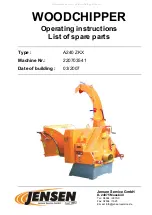
7
MAINTENANCE
7.1
General Requirements
The units have been designed to operate continuously
provided they are regularly maintained and operated
within the limitations given in this manual. Each unit
should be included in a routine schedule of daily
maintenance checks by the operator/customer, backed
up by regular service inspection and maintenance visits
by a suitably qualified and trained Service Engineer.
It is entirely the responsibility of the owner to provide for
these regular maintenance requirements and/or enter
into a maintenance agreement with a JCI service
organisation to protect the operation of the unit. If
damage or a system failure occurs due to improper
maintenance during the warranty period, JCI shall not
be liable for costs incurred to return the unit to
satisfactory condition.
This maintenance section applies to the basic
unit only and may, on individual contracts, be
supplemented by additional requirements to
c o v e r a n y m o d i f i c a t i o n s o r a n c i l l a r y
equipment as applicable.
The Safety Section of this manual should
be read carefully before attempting any
maintenance operations on the unit.
7.2
Daily Maintenance
The following maintenance checks should be carried
out on a daily basis by the operator/customer. Please
note that the units are not generally user serviceable
and no attempt should be made to rectify faults or
problems found during daily checks unless competent
and equipped to do so. If in any doubt, contact your local
JCI Service Agent.
Unit status
: If the Alarm LED is on select the Alarm
Mode on the display by pressing and holding SW3 and
SW4 for 3 seconds.
Press SW3
p
or SW4
q
to scroll through the alarms.
The display will automatically toggle (
E
) between the
alarm number and one of the alarm codes as detailed in
the alarm code table
(refer to the Section 6 for
explanation of messages and the Trouble Shooting
section for courses of action).
Refrigerant leaks
: Visually check the heat exchangers,
compressors and pipework for damage and gas leaks.
Operating conditions
: Read the operating pressures
and temperatures at the control panel using SW3 and
SW4 and check that these are within the operating
limitations.
Compressor oil level
: Check the compressor oil level
after the compressor has been operating on ‘FULL
LOAD’ for approximately half an hour.
Refrigerant charge
: When a system starts up, or
sometimes after a change of capacity, a flow of bubbles
will be seen in the liquid line sight glass. After a few
minutes of stable operation, the bubbles should clear
leaving just liquid refrigerant showing in the sight glass.
7
-
1
035-21786-100 Rev. 1 (0909)
Summary of Contents for York YCRE 040
Page 2: ......
Page 49: ...9 3 035 21786 100 Rev 1 0909 Suction Pressure Evaporator Sub cooling Temperatures...
Page 54: ...9 7 Clearances and Foundations 9 8 035 21786 100 Rev 1 0909...
Page 55: ...9 8 Dimensions 9 9 035 21786 100 Rev 1 0909 Model YCSE 040...
Page 56: ...9 10 035 21786 100 Rev 1 0909 Model YCSE 050...
Page 57: ...9 11 035 21786 100 Rev 1 0909 Model YCSE 060...
Page 58: ...9 12 035 21786 100 Rev 1 0909 Model YCSE 080...
Page 59: ...9 13 035 21786 100 Rev 1 0909 Model YCSE 100...
Page 60: ...9 14 035 21786 100 Rev 1 0909 Model YCRE 040...
Page 61: ...9 15 035 21786 100 Rev 1 0909 Model YCRE 050...
Page 62: ...9 16 035 21786 100 Rev 1 0909 Model YCRE 060...
Page 63: ...9 17 035 21786 100 Rev 1 0909 Model YCRE 080...
Page 64: ...9 18 035 21786 100 Rev 1 0909 Model YCRE 100...
Page 66: ...This Page Intentionally Blank 10 2 035 21786 100 Rev 1 0909...
















































